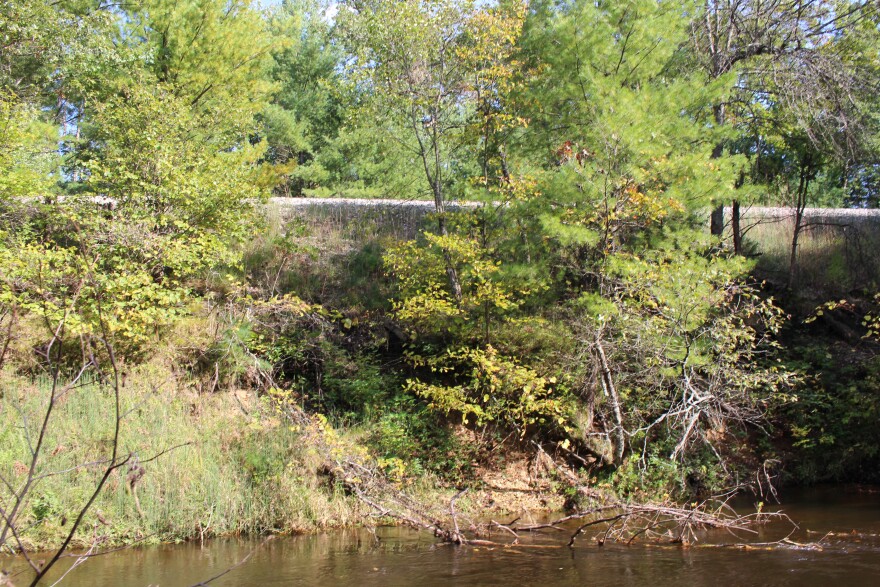
The Pere Marquette River is a nationally recognized trout stream attracting anglers from all over the world.
Ten years ago, fishermen started noticing unstable land just below a rail line that crosses the Pere Marquette.
Locals are worried that the train will soon derail, spilling train cars with chemicals into the river. Some say it may be too late to stop a disaster.
On a warm early fall day, Park Smith walks alongside the curvy path of the Pere Marquette River.
The fly fisherman says he admires the river, which is spring-fed and cold enough to support brown trout.
“This is where brown trout, german brown trout taken from [a] farm in Basel, Switzerland came to America,” he says.
Smith is a member of the Flint Rainbow Club, a private fishing club operating since 1916. He and the other members of the club worry the prized trout are in danger.

For years the river has slowly cut into the steep land beneath an active railway. Trees once dotting the higher parts of the sandy bank have caved into the water.
“And as you can see that tree is almost literally in mid air,” Smith says. “The soil underneath it has eroded and you can see the roots hanging out. This one over here has fallen in. There’s another one gone now that was over there. It fell in about two years ago.”
Smith says erosion happens slowly over many decades, but with an intense water event, like prolonged rain or ice, pieces of land can crumble without warning.
“If this settles and becomes uneven the [train cars will] fall over,” he says. “This will be the low side and you see that is straight downhill, they’re in the river. You either have a slick of this asphalt base or you poison the river with the chemicals.”
Smith has watched train cars roll by with the car’s contents written on them: asphalt, road salt, magnesium hydroxide slurry.
Mark Tonello, a fisheries biologist for the Michigan Department of Natural Resources, says if the train’s contents were to end up in the water it would devastate the river’s ecology.
“You can create a biological oxygen demand where you suck … all the oxygen out of the water and kill fish that way,” Tonello says. “There’s a number of different things that could happen.”
He adds it would be a tough blow to the local economy, which relies on river recreation tourism.
“If a train were to go into that river it would be a really big deal,” Tonello says. “It would make national news, and it would be a big black eye to everyone involved.”
On the opposite side of the river is Jim Bos’ home. He is the president of the Pere Marquette Watershed Council and has been working on the erosion problem for a decade.

Twice a day Bos feels the earth rumble around his house several hundred feet away from the train pulling about 50 cars. He says the rail company maintains the tracks well.
“But they inspect it from up there,” Bos says. “I’ll challenge you to see where the water hits the soil from up there. You can’t see it, it’s too vertical.”
He says the rail inspectors don’t see how fragile the land is beneath.
Genesee & Wyoming, a Connecticut-based company, currently owns the train tracks says the erosion is not happening on their property, so it’s not their responsibility. The company says it monitors the location closely and would take action long before any unsafe conditions develop.
Bos disagrees. He says the situation is already urgent because of high water levels.
“We’ve seen you know with the climate change there’s bigger storms,” he says. “When we get rain, it’s not a quarter inch anymore, it’s an inch and a quarter. So there’s going to be more wear and tear on this bank, I think, going forward.”
In June, Bos says Michigan SenatorCurt VanderWallhelped arrange a meeting between the local group and the railroad company. The company then agreed to let the Watershed Council build up the bank with gravel to better secure the railroad tracks. As part of the project, the Watershed Council is also looking to plant vegetation to further root the foundation in place.
But just as the effort moves forward, the council is losing some steam. Bos says the engineering designs have cost $73,000, and the construction itself will cost several hundred thousand dollars. It will also take time to apply for special permits and grants. It will likely be at least another two years before construction can begin.
This story appeared in IPR’s weekly show Points North. You can find the whole episode here.
Copyright 2019 Interlochen Public Radio



